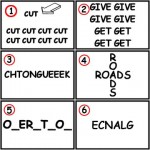Commentary #1 ~ The use of symbols for early language acquisition
Commentary #1
Kelly Kerrigan ETEC 540- Section 65A
The use of pictures to convey meaning or as tool to aide memory has been used both in traditional oral cultures and literate cultures. Ong, in his book Orality and Literacy (1982), discusses the ideas of rebus writing, ideographs, and pictographs in both cultures, including specific cultural examples. I will first summarize these ideas and examples and then will further the argument that pictures are a necessary part of language acquisition in a literate culture. Specific focus will be on younger learners, those who are learning disabled, and secondary language learners.
Ong (1982), discusses the use of symbols and pictures as the beginnings of the modern alphabet. “Most if not all scripts trace back directly or indirectly to some sort of picture writing…”(p.85). One example that is still used today is the Chinese writing system, a complex array of characters which takes, on average, twenty years to master. This writing system enables a level of understanding that would not happen orally, due to the diverse collection of dialects within the Chinese culture. The use of pictographs, symbols that convey meaning to a physical object, allows for scripts to emerge, however with each culture each will use a different meaning associated with the symbol. For example, an image of a book could mean simply a book, or it could mean a building, such as a library, depending on the cultural use. Similarly, an ideograph, according to Ong, is where the “…meaning is a concept not directly represented by the picture but established by a code” (p. 86). Egyptian hieroglyphs contain examples of pictographs, ideographs, and rebus writing. Rebus writing, another type of pictograph is a sound/symbol, with the symbol representing what the sound signifies. Since the English language has many homonyms, the meaning of the word might not be immediately clear. An example that Ong points out is the picture of a foot, with an arrow pointing to the sole. In rebus writing, the image could mean the sole of the foot, the spiritual soul, or a type of fish. Rebus puzzles are now commonly used in educational settings.

Example: Rebus Puzzle
Image source: victorkoo.blogspot.com/2008_04_01_archive.html
Ong discusses pictographs with specific attention to their use in oral cultures. I must expand on his explanations in saying that the use of pictographs is also incredibly important in the language acquisition of young learners, those who are learning disabled, and secondary language learners. When young children begin to acquire language, it is done so aurally, with children picking up phonemes and basic word commands from a very young age. Their baby babble then moves into more audible reflection of everyday speech. When children enter school, their vocabulary increases, however it is when a child sets down to write in a literate culture, that symbols and pictures begin to aid in their learning. Much like young learners, older learners will use pictures as a way to aid their memory for specific tasks (aides memoire). Their aides memoire, however are not as rudimentary as those who are in the early stages of language acquisition. “In the semi-phonetic stage, we’ve found children use one, two or three letters to represent words [in their writing]…represent[ing] some speech sounds heard in the words” (Cook.1995, p.66). Most children will soon move from this stage and introduce vowels and form more coherent written word, however for learning disabled students, this is not always the case. “… The ability to make paradigmatic responses in oral language tasks does not ensure that a child will automatically transfer and apply this ability to written language tasks…” (Cartelli, 1978, p. 314).
Learning disabled students, in Cartelli’s (1978) study “…appeared to experience major difficulty in organizing key verbal elements and in understanding the use of language in unlocking the written symbolic code” (p.318) This has major implications for those teachers who work with learning disabled students, for more emphasis must be placed on the use of symbols to represent verbal and written language. Some learning disabled students only use pictures as a form of language communication. The use of pictographs to create sentences and to respond to commands (either by pointing to a fixed board, or using specialized technology to type out answers) are the only way for non-verbal children to communicate in the literate world. The same can be said for secondary language learners. In the early stages of language acquisition, many learners are parroting or mimicking other native speakers. They will respond well to visuals from the start, and will then use these same pictures as support for questions and small assignments later on (Haynes, 2005, n.p.).
To conclude, the use of pictographs have their place in both oral and literate cultures. The necessity of using pictographs, including rebus writing and ideographs within the classroom, have shown to have merit for early language acquisition. Learners rely on the use of symbols to communicate from a basic rudimentary level as well as at a cognitive level for those who are non-verbal and learning disabled.
References:
Cartelli, L. (1978). Paradigmatic Language Training for Learning Disabled Children. Journal of Learning Disabilities, 11(5).
Haynes, J. (2005) Stages of Second Language Acquisition.
Retrieved October 1, 2009 from http://www.everythingesl.net/inservices/language_stages.php
Ong, W. J. (1982). Orality and Literacy: The Technologizing of the Word. London and New York: Methuen.
Robertson, K., & Randolph, L. (1995). First steps for early writers. Teaching Pre K-8, 25(6), 66.


1 comment
1 Clare Roche { 11.28.09 at 6:04 pm }
Do you think “using pictographs, including rebus writing and ideographs within the classroom” would be equally as useful in a second language classroom?
You must log in to post a comment.